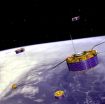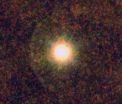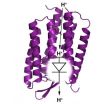(Press-News.org) Cluster has spent a decade revealing previously hidden interactions between the Sun and Earth. Its studies have uncovered secrets of aurora, solar storms, and given us insight into fundamental processes that occur across the Universe. And there is more work to do.
The aurora, those dancing lights in the polar skies, are but the visible manifestation of an invisible battle taking place above our heads. Supersonic particles from the Sun collide with our planet's magnetic field every day. Most are deflected away but some are trapped by Earth's magnetism and accelerated to collide with the atmosphere, creating the aurora, the planet's radiation belts and from time to time large magnetic storms worldwide.
In its decade studying this activity, Cluster has discovered giant magnetic whirlpools injecting new particles into Earth's field, huge 'holes' in the uppermost atmosphere of Earth that create black regions in the visible aurora, and magnetic dead spots called nulls that form just as the magnetic landscape of space is about to snap into a new configuration.
"Cluster has shown us a previously hidden world of new details," says Philippe Escoubet, ESA Cluster Mission Manager. As well as understanding the aurora, Cluster has a practical side: it unveils the environment that spacecraft such as navigation and communications satellites are expected to work in. Solar particles can damage spacecraft electronics, sometimes critically, so Cluster's characterisation of this danger can lead to more robust satellite design.
There is a global science community working on Cluster. Every other day, a science team somewhere in the world has a paper accepted for publication that relies on Cluster data. The Cluster Active Archive already possesses more than 1000 users worldwide, ensuring that the science results will continue even after the mission itself comes to an end.
Ten years is a long time in the severe condition of space. The four Cluster spacecraft are all showing their age and the operations team face a daily challenge to keep the fleet operational. Perhaps the biggest task is to make sure the power keep flowing.
The solar panels no longer generate as much electricity as they did, and the batteries onboard are gradually breaking down in a dramatic way: a series of minor explosions. The batteries are made of non-magnetic silver-cadmium to avoid interfering with Cluster's instruments. But over time, such batteries generate oxyhydrogen, an explosive gas. To date seven batteries have cracked across the four spacecraft, two of which were more like small explosions. Ground controllers saw the spacecraft lurch each time this happened. From twenty batteries, just nine remain. Yet new, creative scenarios for operations mean the spacecraft remain almost fully functional despite the loss of battery power.
And there is a lot still to be done. Recently, Cluster's approach to Earth was lowered from 19 000 km to just several hundred kilometres. This will sweep Cluster through the regions responsible for the final acceleration of auroral particles, giving scientists an unparalleled view of this behaviour.
Whilst Cluster is firmly in orbit around the Earth, its science is fundamental to our understanding of the most distant realms of the Universe.
"We are doing astrophysics close to home," says David Southwood, ESA Director of Science and Robotic Exploration, "Beyond the solar system is an enormous Universe, filled with uncountable stars. The spaces in between them are full of magnetic fields. Other missions study the objects – the islands in the universal ocean – but Cluster studies the very ocean itself."
Cluster is expected to operate until 2012. A mission extension is under review to extend its operations to 2014.
INFORMATION:
Cluster turns the invisible into the visible
2010-09-04
ELSE PRESS RELEASES FROM THIS DATE:
Miniature auto differential helps tiny aerial robots stay aloft
2010-09-04
CAMBRIDGE, Mass., Sept. 2, 2010 -- Engineers at Harvard University have created a millionth-scale automobile differential to govern the flight of minuscule aerial robots that could someday be used to probe environmental hazards, forest fires, and other places too perilous for people.
Their new approach is the first to passively balance the aerodynamic forces encountered by these miniature flying devices, letting their wings flap asymmetrically in response to gusts of wind, wing damage, and other real-world impediments.
"The drivetrain for an aerial microrobot shares ...
Dynamic memory mapping delivers additional flexibility to virtual resource management
2010-09-04
The Department of Computer Science and Technology, Peking University, Beijing, China, has shown that a novel dynamic memory mapping (DMM) model brings about additional flexibility to virtual resource management, leading to the feature-adjustable design of a virtual machine monitor (VMM). The study is reported in Issue 53 (June, 2010) of SCIENCE CHINA Information Sciences because of its significant research value.
Memory is one of the most frequently accessed components in virtual machine (VM) systems. Because a VM's memory requirement varies according to the running applications, ...
Effect of heat treatment on the superconducting properties of Ag-doped Sr0.6K0.4Fe2As2 compounds
2010-09-04
The Key Laboratory of Applied Superconductivity, Institute of Electrical Engineering, Chinese Academy of Sciences, Beijing, and China Research have collaborated to reveal the heat treatment effects on the superconducting properties of Ag-doped Sr0.6K0.4Fe2As2 compounds. Because of its significant research value, the study is reported in issue 7 of SCIENCE CHINA Physics, Mechanics & Astronomy.
Previously, our group studied the effect of adding Ag to polycrystalline Sr0.6K0.4Fe2As2 and found that the critical current density Jc and the irreversibility field increase markedly. ...
Image-based modeling of inhomogeneous single-scattering participating media
2010-09-04
The State Key Laboratory of Virtual Reality Technology and Systems, Beihang University in Beijing, has proposed an image based modeling method for inhomogeneous single-scattering participating media whose density fields may contain high frequency details [1]. This work could reduce the difficulty in capturing real-world participating media, which can be applied to 3D games, film production, virtual reality systems, etc. This study is reported in Volume 53 (June, 2010) of the Science China Information Sciences journal because of its significant research value.
Realistic ...
Medicinal cannabis review highlights dilemmas facing health care professionals
2010-09-04
Nurses have a responsibility to respect and support patients who use cannabis for medicinal purposes, but must stay within the law and follow professional guidance at all times, according to a research review in the September issue of the Journal of Clinical Nursing.
Dr Anita Green and Dr Kay De-Vries studied more than 50 published papers, together with professional and Government guidance documents, official reports and media coverage, from 1996 to 2009.
They point out that the fact that the cannabis is usually obtained illegally can have consequences for those who ...
Recipe for water: Just add starlight
2010-09-04
ESA's Herschel infrared space observatory has discovered that ultraviolet starlight is the key ingredient for making water in space. It is the only explanation for why a dying star is surrounded by a gigantic cloud of hot water vapour.
Every recipe needs a secret ingredient. When astronomers discovered an unexpected cloud of water vapour around the old star IRC+10216 in 2001, they immediately began searching for the source. Stars like IRC+10216 are known as carbon stars and are thought not to make much water. Initially they suspected the star's heat must be evaporating ...
Long term use of oral bisphosphonates may double risk of esophageal cancer
2010-09-04
People who take oral bisphosphonates for bone disease over five years may be doubling their risk of developing oesophageal cancer (cancer of the gullet), according to a new study published on bmj.com today.
Oral bisphosphonates are a type of drug used to treat osteoporosis and other bone diseases and are the most commonly recommended treatment for such conditions.
Case reports suggest an association between use of oral bisphosphonates for osteoporosis and increased risk of oesophageal cancer. But the evidence is limited, and no adequately large study with information ...
Roll-out of electronic patient records likely to be a long and complex process
2010-09-04
Interim results from the first comprehensive evaluation of the implementation of electronic health records in secondary care in England have found delays and frustration with the system, according to research published on bmj.com today.
The authors, led by Professor Aziz Sheikh from The University of Edinburgh (and which included researchers from The London School of Economics and Political Science, The School of Pharmacy and The University of Nottingham), say experiences from the first-wave implementation site "indicate that delivering improved healthcare through nationwide ...
Scientists unwrap DNA packaging to gain insight into cells
2010-09-04
Scientists have built a clearer picture of how lengthy strands of DNA are concertinaed when our cells grow and divide, in a discovery could help explain how cell renewal can go wrong.
Scientists have identified thousands of proteins that play a key role in compacting DNA – a crucial process by which DNA is shortened up to 10,000 times to fit inside cells as they split into two.
Researchers hope the findings could shed light on what happens when this packaging process fails and cells divide abnormally – which can lead to cancer or cause developing embryos to miscarry.
Scientists ...
Bochum's researchers discover proton diode
2010-09-04
Biophysicists in Bochum have discovered a diode for protons: just like the electronic component determines the direction of flow of electric current, the "proton diode" ensures that protons can only pass through a cell membrane in one direction. Water molecules play an important role here as active components of the diode. The researchers led by Prof. Dr. Klaus Gerwert (Chair of Biophysics at the RUB) were able to observe this through a combination of molecular biology, X-ray crystallography, time-resolved FTIR spectroscopy and biomolecular simulations. They report in the ...



